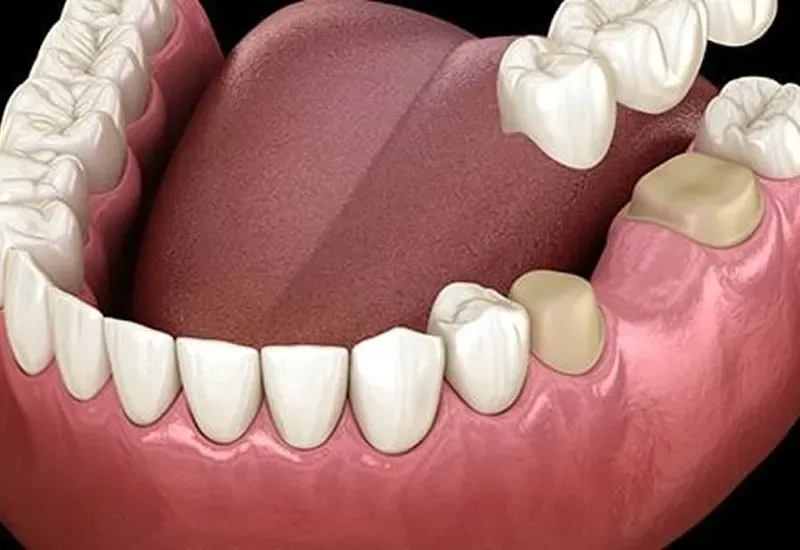Long-Term Benefits of Dental Bridges: A Smart Investment for Your Teeth

by Dr. Uvika Singh
11 April 2025

When it comes to missing teeth, dental bridges are a popular option in restorative dentistry. They not only fill the gaps left by missing teeth but also provide several long-term benefits that make them a smart choice for maintaining oral health.
We will look at the advantages of dental bridges, the different types available, the treatment process, and the costs involved.

An Overview of Dental Bridges
Dental bridges are fixed devices designed to replace one or more missing teeth. They are held in place by nearby natural teeth, called abutment teeth, or supported by dental implants. A bridge consists of one or more artificial teeth, known as pontics, which fill the gaps left by the missing teeth.
Dental bridges can greatly improve both the function and appearance of your smile. They are usually made from materials like porcelain, ceramic, or metal, which can be matched to the color of your natural teeth, making them a nice-looking option.
Types of Dental Bridges
Before we discuss the benefits, let’s look at the different types of dental bridges available.
- Traditional Dental Bridges: This is the most common type. It consists of one or more pontics supported by dental crowns placed on the abutment teeth. They are great for patients with healthy adjacent teeth.
- Cantilever Bridges: These are used when there is only one nearby tooth for support. Cantilever bridges are usually placed in areas where chewing forces are lower, like the front teeth.
- Maryland Bridges: These braces use a metal or porcelain framework to hold the pontic in place. They are less invasive than traditional bridges since they don’t require crowns on the adjacent teeth.
- Implant-Supported Bridges: These bridges are anchored by dental implants instead of natural teeth. They offer more stability and are often recommended for patients missing several teeth in a row.
By understanding these types, individuals can make informed decisions about which dental bridge might be the best fit for their needs. Dental bridges can be a great solution to restore your smile and improve your quality of life.

Long-Term Dental Bridge Advantages
Investing in dental bridges offers several long-term benefits that can greatly enhance both your oral health and quality of life.
Improved Functionality
One of the main dental bridges benefits is that they restore functionality. Missing teeth can make it hard to chew and speak. Dental bridges allow you to bite, chew, and speak comfortably, so you can enjoy a wider variety of foods and engage in social interactions without feeling embarrassed. This improved functionality can lead to a happier and more fulfilling lifestyle.
Aesthetics and Confidence
Dental bridges can significantly enhance the appearance of your smile. They fill in the gaps left by missing teeth, creating a complete and more attractive smile. This improvement can boost your self-esteem and confidence, making social situations more enjoyable. Feeling good about your smile can positively influence your interactions with others.
Prevention of Teeth Shifting
When teeth are missing, nearby teeth may shift out of place over time, causing bite problems and other dental issues. Dental bridges help keep the surrounding teeth in their proper position, preventing unnecessary movement and maintaining overall alignment. This stability is important for long-term oral health.
Long-Term Durability
Dental bridges are designed to last a long time. With proper care, they can last anywhere from 10 to 15 years or even longer. This durability makes them a worthwhile investment, as they provide years of improved function and appearance. Knowing that your investment will last gives you peace of mind.
Protection for Abutment Teeth
By placing crowns on the abutment teeth, dental bridges offer extra protection against wear and tear This added protection helps prevent potential dental problems for those teeth, contributing to your overall oral health. Taking care of your abutment teeth can save you from future dental issues.
Ease of Maintenance
Taking care of dental bridges is relatively simple. With regular brushing, flossing, and routine dental check-ups, you can keep your bridges in great shape. This ease of maintenance is one of the reasons many people choose dental bridges as a solution for missing teeth.
Cost-Effectiveness
While the initial cost of dental bridges might seem high, they often turn out to be a cost-effective solution in the long run. Their durability means you can avoid the costs associated with more frequent replacements or repairs that might be needed with less sturdy options. Ultimately, investing in dental bridges can save you money and provide lasting benefits.
Cost of Dental Bridges
The dental bridge cost can vary quite a bit depending on several factors. There are both budget options and luxury packages available out there.
Traditional bridges tend to be less expensive, while implant-supported bridges can cost more because they involve additional surgical procedures. Many dental insurance plans will help cover part of the cost. So, it is worth checking with your insurance provider.
Pro tip: Always discuss financial options with your dentist to find the best and most affordable dental bridge solution for your budget.
Dental Bridge Process: What to Know?
Let's break down the journey of the Dental Bridge Treatment Process into simple steps.
Initial Consultation
This is where everything begins. You will meet with a dentist who will check your oral health and discuss bridge options. They will likely take X-rays and impressions to get a complete picture of your teeth.
Tooth Preparation
If you are getting a traditional bridge, the dentist will reshape the supporting teeth to make room for the crowns. Don't worry, they will use local anesthesia to keep you comfortable during this process.
Taking Impressions
Once your teeth are prepared, the dentist will take detailed impressions of your mouth. These are sent to a dental laboratory where your custom bridge will be created.
Temporary Bridge
While your permanent bridge is being made, you will get a temporary bridge. This protects your prepared teeth and helps you maintain a nice smile during the waiting period.
Placing the Permanent Bridge
When your permanent bridge is ready, you will return to the dentist for the final placement. They will carefully fit the bridge, making any necessary adjustments to ensure it feels comfortable and looks natural. Then, they will fix it securely in place.
Follow-Up Care
After your bridge is placed, you will have follow-up visits to make sure everything is working perfectly. Regular check-ups are crucial for keeping your new bridge and surrounding teeth healthy.

“Blessed are those who can hold lively conversations with the helplessly mute, for they shall be called dentists." – Ann Landers
Before and After Care for Dental Bridges
Taking good care of your teeth before and after getting dental bridges is crucial for their success and long-lasting performance. Here are some easy tips for patients.
- Make sure your existing teeth are clean and healthy before the procedure. Brushing and flossing regularly can help prevent infections and complications.
- Let your dentist know about any medications you are taking or any medical conditions you have that might affect the procedure. This helps ensure everything goes smoothly.
- Be aware that you might feel some discomfort after getting the bridge. Preparing a soft-food diet for a few days can help make recovery easier.
- Keep brushing and flossing regularly, paying special attention to both the bridge and the surrounding teeth. Using special flossing devices or interdental brushes can help clean around the bridge more effectively.
- For the first few days after getting your bridge, stay away from hard or sticky foods that could stress the new bridge.
- Schedule regular dental visits to keep an eye on your bridge and overall oral health. This proactive approach can help catch any issues early on.
- If you notice any discomfort, looseness, or changes in the bridge, contact your dentist right away to address any concerns.
Conclusion
Dental bridges are an effective and long-lasting solution for people with missing teeth. They don’t just improve how you look; they also enhance your ability to chew and speak, boost your confidence, and contribute to better oral health.
Investing in dental bridges for missing teeth can lead to significant long-term benefits. By restoring your ability to chew and speak effectively, preventing teeth from shifting, and providing a natural appearance, dental bridges can greatly enhance your quality of life.
Contact your dentist today in Oakland, Dr. Uvika Singh, at Advance Dental Concepts Oakland, to learn more about dental Long-Term Benefits of Dental Bridges.
Resource:
Share This:
Disclaimer
*This media/content or any other on this website does not prescribe, recommend, or prevent any treatment or procedure. Therefore, we highly recommend that you get the advice of a qualified dentist or other medical practitioners regarding your specific dental condition. *

Subscribe to Our Newsletter
Stay informed about the latest dental news, tips, and promotions by subscribing to our newsletter. Enter your email address below to join our community of smile enthusiasts.
